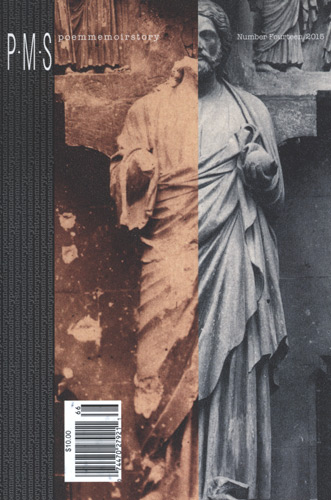PMS poemmemoirstory – 2015
Oh literature, oh the glorious Art, how it preys upon the marrow in our bones. It scoops the stuffing out of us, and chucks us aside. Alas! ~ D.H. Lawrence
The works of poetry, memoir, and story in the 2015 issue of PMS: poemmemoirstory aspire to and achieve Lawrence’s requirements of literature. The pieces are finely crafted, yes, but, more, are significant in that they strive to reach readers on deep levels. This journal, publishing women writers for fifteen years, continues to showcase literature that is art, and that matters to readers of any persuasion.
Oh literature, oh the glorious Art, how it preys upon the marrow in our bones. It scoops the stuffing out of us, and chucks us aside. Alas! ~ D.H. Lawrence
The works of poetry, memoir, and story in the 2015 issue of PMS: poemmemoirstory aspire to and achieve Lawrence’s requirements of literature. The pieces are finely crafted, yes, but, more, are significant in that they strive to reach readers on deep levels. This journal, publishing women writers for fifteen years, continues to showcase literature that is art, and that matters to readers of any persuasion.
“Poetry is finer and more philosophical than history; for poetry expresses the universal, and history only the particular.” ~ Aristotle
The poetry in this issue evokes memory through sensory imagery and the telling of stories with universal themes, even though not every poem in the issue is narrative. In Stephanie Kaplan Cohen’s “The Cross Dressing Cantaloupe,” for instance, the description is the story that anthropomorphizes the melon, explaining first that it “likes to fool the crowd, / wears a mask / and feet dressed up in ballet slippers.” The imagery is a challenge to readers to view things differently or allow metaphor into their lives for whimsy or import. Lisa Zerkle uses powerful imagery of fresh roadkill in her poem “Transformation” to transport the reader to a place where noticing and contemplating everything can be powerful. Her first stanza informs us of what we may already know, that the dead possum on the road is “A mortal reminder / no sooner passed / than forgotten,” and she, in her lines evoking the process of the disappearing corpse from the tarmac, has said what some may not be willing to admit, that death inevitably is the final disappearing act.
Other poems in the issue tell evincing stories steeped in the memory of loved ones, some familiar narratives shared by many but crafted in lines of poetry. Christine Higgins’s “Having a Daughter” begins mentioning Father’s Day but is really a story of a mother-daughter relationship that cannot escape the fate of generations. The following lines speak to the need for mothers to give their children the nurturing, love, or experience that they as daughters did not receive from their mothers; the kismetic reality, however, is that daughters cannot escape their mothers, and mothers cannot fill all of the negative space from their own girlhood. The tragic moment is the realization of the mother that some of it is somehow predestined and unalterable:
You think she’d be made strong
and secure by all the affirmation,
but no, she’s just like me:
cries for the dead dog in the movie,
works so hard at erasing her mistakes,
she makes holes in the paper, as if
the child I once was is seeping through.
With these lines, Higgins has tapped into the emotions of mothers and daughters who become mothers of daughters. With similar perception, Jenna Rindo’s “Step Over Cracks” uses this bit of folklore to begin an homage to a grandmother who:
Roasts a cheap cut of meat ’til it falls
from the bone. Works third shift at
the Xerox plant. Walks the dogs, rocks the
cradle, entertains all variety of strangers.
Rindo uses caesura to great effect in this listing of the speaker’s grandmother’s attributes and throughout the poem, culminating in what she imagines her grandmother hopes for. The issue contains a number of insightful narrative and lyric poems that conjure memory through place and time.
“By definition, memoir demands a certain degree of introspection and self-disclosure: In order to fully engage a reader, the narrator has to make herself known, has to allow her own self-awareness to inform the events she describes.” ~ Caroline Knapp
The pieces of memoir in this issue also aspire to the evocative with writing of experience that searches for and discloses meaning in life’s events and perceptions. In “Culinary Alchemy,” Christine Stewart-Nunez draws parallels between cooking and witchcraft, the carefully prepared foods casting spells on family and friends. She tells us, “I treasure hunt for recipes so I may reproduce their power, so I’ll know what they know—how to dazzle, nurture, sustain.” Through engaging prose, she sustains the metaphor throughout the piece.
The writers Denise Duhamel and Julie Marie Wade also use metaphor in their collaborative piece “Green,” in which the writers alternate in a conversation about travels and experiences and what connections and iterations of green meant to them in their global education. The writers’ prose of memory includes all possible green connections they might have made, sifting through experience for the ultimate green references that matter most. Connections between the two authors in their conversation are fostered in the transition from one writer’s voice to the other. The effect is comforting rather than jarring; some green references, however, seem a bit more strained or cliché, such as “green around the gills.” or “green with envy.” The overall effect of “Green” is pleasurable for the thrill of recognition and is a conversation readers shouldn’t miss.
“Fiction is like a spider’s web, attached ever so slightly perhaps, but still attached to life at all four corners. Often the attachment is scarcely perceptible.” ~ Virginia Woolf
The stories in this issue are attached to human nature and experience; they use this attachment to convey deeper truths and to allow readers to connect with characters and settings even if these seem unfamiliar at first. The imperceptible attachment is also to writers who have come before and paved the way, such as Welty, Cather, and Lessing who wrote of the overwhelming truths in women’s lives. Maura Stanton’s “One Hundred Famous Views” is a rewarding trip with the narrator who finds herself in search of a new place to live when her landlords give her notice. As an artist needing the views for her project “One Hundred Famous Views of Venice,” she is on a mission to find another apartment that will suit her needs. The culmination of her search coupled with realization is a satisfying experience for the reader. Jane Hertenstein’s “Heartbreak Wall” is another reading experience evoking cathartic sensations and hammering home the cruel truth in life. Metaphor, imagery, and setting all conspire in the well-knitted plot surrounding the protagonist, Mette, whose thoughts are made known as she acts to extricate herself from her future and wonders “what her family would think when they awoke to find her missing.” Hertenstein has tightly constructed a story that dissolves the space between it and the reader.
In all of the stories in this issue of PMS, readers will find craft and style befitting works of literature. Readers offering themselves up to be chucked aside will leave satisfied with the experience.
[www.uab.edu/cas/englishpublications/pms-poemmemoirstory]





